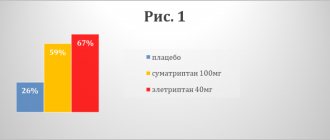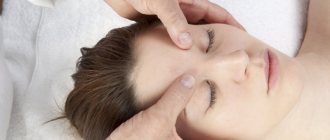Migraine
is a chronic disease that manifests itself in the form of sudden attacks of severe headache, often accompanied by nausea and, in some cases, vomiting.
Photophobia and sound intolerance may also occur before and during attacks. Migraine
Migraine is a neurological disease. It is associated with disturbances in the activity of brain structures responsible for pain and other sensations. Migraine attacks can last from several hours to 3 days. The frequency of attacks also varies: from once or twice a year to 2-8 times a month, in some cases more often.
Migraine can be considered a widespread disease - one in seven adults suffers from migraine. Migraines occur three times more often in women than in men.
Manifestations of migraine are more typical for young or mature people. Usually the disease appears at the age of 18-33 years, less often - at an older age, after 50 years - extremely rarely. Cases of the disease have been reported in children over 5 years of age. After 60 years, the severity and frequency of attacks disappear, the disease, as they say, “goes away.”
Causes of migraine
Migraine headaches are caused by changes in the lumen of blood vessels in the skin and muscles of the head. The vessels first contract and then expand sharply. The phenomena of aura are associated with a similar two-phase change in the lumen of the carotid artery, which supplies the brain. Modern research notes that migraine attacks occur against the background of increased activity of the brain and autonomic systems. After an attack, the state of these systems returns to normal. Migraine is typical for people engaged in mental work. Among people whose activities involve constant physical activity, migraine practically does not occur.
Meanwhile, the mechanism of migraine has not yet been fully studied. Factors that increase the risk of seizures
, are:
- heredity;
- low resistance to stress, mental imbalance, tendency to depression;
- chronic fatigue;
- smoking;
- diabetes;
- in women – menstruation, pregnancy, menopause;
- taking hormonal drugs.
Factors that are the “trigger mechanism” of an attack are separately identified:
- psycho-emotional stress (stress, strong emotional arousal);
- strong physical activity;
- weather changes (atmospheric pressure fluctuations);
- lack of sleep or, conversely, excessive sleep;
- alcohol (red wine is highlighted);
- some types of products (chocolate, hard cheeses, smoked meats, coffee, fish).
Clinical picture
A migraine attack may be preceded by worsening mood, irritability, anxiety, decreased performance, tearfulness, drowsiness, changes in appetite, increased sensitivity to loud sounds, increased lighting. The duration of an attack of unilateral intense headache of a pulsating nature is 4–72 hours. More often, pain appears first in the back of the head and spreads forward to the frontal region (70%).
Pain in the head interferes with the performance of usual activities and intensifies with adequate physical activity (walking). During a migraine attack, patients develop high sensitivity to bright light, noise, and strong odors. Typical pain behavior - patients try to hide, take a motionless position in a darkened, quiet room. Nausea (70%) and vomiting (30%) are observed. Headache attacks are sometimes accompanied by swelling of the face, pale skin, lacrimation, and rapid heartbeat. Taking analgesics does not relieve headaches. Remissions occur after treatment for several weeks or months.
An objective examination of the patient reveals general hyperesthesia, photophobia/phonophobia/osmophobia, cerebral syndrome, tension and soreness of the pericranial muscles, emotional-volitional disorders and autonomic dysfunction.
Migraine symptoms
An attack may begin with a phase of “harbingers” - symptoms immediately preceding an attack of pain.
Below is a general list. These symptoms may appear in different combinations in different people.
Precursors usually appear several hours (in some cases days) before the onset of pain. However, quite often a migraine attack develops without going through the “precursor” phase.
Headache
Pain can occur at any time of the day, but most often it begins at night, during sleep, in the morning or immediately after waking up. Migraine is characterized by unilateral pain, focusing in the frontotemporal region with involvement of the eyeball. In 20% of cases, pain occurs immediately as bilateral; more often, having arisen as one-sided, the pain subsequently spreads to the other side. The nature of the pain is usually pulsating, sometimes bursting.
More about the symptom
Reduced threshold of excitability of sensory organs
Pain may be accompanied by an increased reaction to sensory stimuli - light, sounds, smells, touching the body - everything can increase pain. During an attack, the patient tries to retire, go to bed, darken the room, that is, reduce all external influences to a minimum.
Aura
In approximately 20-25% of cases, the disease has a specific “aura” phase. Migraine with aura is considered a classic form of the disease - this is how it was originally described. Ordinary migraine (without aura) was included in the description of the disease later.
Migraine aura is a complex of neurological symptoms that precedes and sometimes accompanies an attack of pain, and represents disturbances of various types of sensory perception that pass without consequences during the attack.
If an attack develops with an “aura” phase, this phase usually includes the warning symptoms observed in ordinary migraine. Specific manifestations of the aura can be as follows:
- the patient sees flashes of light, flickering dots, balls, broken lines before his eyes. Migraine with a similar aura is called ophthalmic
. This is the most common form of migraine with aura; - temporary blindness occurs in one or both eyes ( retinal migraine
); - oculomotor functions are impaired, double vision occurs, the pupil on the side of pain dilates ( ophthalmoplegic migraine
); - temporary weakness develops on one side of the body or only in the arm, phenomena of paresthesia may be observed - a feeling of goosebumps crawling across the body, tingling, chilliness ( hemiplegic migraine
); - speech disorders ( aphasic migraine
).
Other, more rare disorders are also possible. The “aura” phase, depending on the type of manifestation, lasts from several minutes to 1 hour.
Other symptoms
Against the background of an attack (pain attack), the following may be observed:
- nausea;
- vomit;
- photophobia;
- lethargy;
- cold hands and feet.
Neurology
V. Oknin V. Oknin
D
This work represents the first nosographic analysis of migraine aura diagnosed according to the criteria of the International Headache Society. In a fairly large representative group (4000 people aged 40 years), attacks of migraine aura with and without headache were observed in 163 people (95 men, 68 women). 7 patients (3 men, 4 women) had only migraine aura without headache. Visual aura symptoms were the most common (99%), followed by sensory (31%), aphasic (18%), and motor (6%) symptoms. Only visual aura often occurs in isolation, while sensory, motor and aphasic aura is almost always combined with visual aura. Migraine aura without headache was experienced by 42% of patients who had migraine with aura, and only 10% of them had migraine aura never accompanied by headache.
Visual aura
7 of 161 patients had only visual aura without headache. A typical visual aura begins with the appearance of a flickering, colorless, unilateral zigzag line in the center of the visual field, gradually expanding to the periphery and often leaving a scotoma. The aura gradually progressed over 30 minutes, its total duration was up to 60 minutes. Only a few patients had prolonged visual aura. In patients who had only a visual aura, there was a tendency to shorten the development time compared to those who had a visual aura combined with its other types.
Sensory aura
The typical sensory aura is one-sided, starting in the arm, spreading to the shoulder and then to the face and tongue. The body and legs are rarely involved. The aura gradually progressed in less than 30 minutes, and its total duration was up to 60 minutes. In approximately 1/5 of the patients, the sensory aura was prolonged. In patients with sensory aura without motor manifestations, there was a tendency to shorten development time. In these patients, the duration of the aura was significantly shorter than in cases of a combination of sensory and motor aura.
Motor aura
All 9 patients with motor aura also had visual and sensory aura. No part of the body was involved in the motor aura without the sensory one. But in 4 patients with sensory aura (without motor) in the face and arm, there was a combination of sensory and motor aura. The motor aura was unilateral and involved the hand and shoulder. The mean time of gradual progression and duration of motor aura were 46 ± 54 min and 13 ± 18 h, respectively.
Aphasic aura
This group includes cases of paraphasia and other disorders of speech production and speech perception that are not caused by headache. Dysarthria also occurred in 15 of 29 patients with aphasic aura. Two patients had dysarthria only (not included in the aphasic aura group). The average duration of the aphasic aura was 43 ± 43 minutes. Visual, sensory and aphasic aura rarely lasted more than 1 hour, unlike motor aura (67% of cases). In 4 patients, an exceptionally acute onset of aura was noted; the duration and nature of the headache that followed it were typical for migraine with aura, which indicates the reality of the phenomenon of acute onset of aura. Headache followed aura in 93% of cases, their simultaneous onset was observed in 4% of cases, aura followed headache in 3% of cases.
Migraine aura without headache
Of the 62 patients with attacks of migraine aura with and without headache, 52 patients had only visual aura in all cases of attacks of migraine aura without headache. Five patients had visual and sensory aura without headache (one of them also had aphasic aura). 3 patients had visual, sensory and motor aura without headache (one of them also had aphasic aura). 1 patient had visual and aphasic aura without headache and 1 patient had exclusively sensory aura without headache. The visual aura tended to lengthen if it was accompanied by a headache - 38 ± 52 minutes, 26 ± 21 minutes - without headache. In 7 patients who suffered exclusively from migraine aura without headache, the average duration of the visual aura was 25 ± 13 minutes.
Discussion
There is evidence that aura symptoms always precede migraine headaches. If the headache occurs before the aura, it is usually a tension headache. Thus, rare cases of headache preceding aura can be explained by attacks of tension-type headache followed by attacks of migraine with aura. According to most previous studies, unilateral migraine pain is equally common both ipsilateral and contralateral to aura symptoms. However, information obtained during an attack indicates that ipsilateral symptoms accompany a minority of attacks. A surprisingly large number of patients had migraine aura attacks with or without headache, but few had migraine aura only without headache. Migraine aura attacks without headache become more frequent with age. Based on nosographic analysis, the authors concluded that the most likely explanation for migraine aura remains cortical depression. Although spreading depression is the most likely trigger for a migraine aura, it is not always severe enough to cause a headache, since half of migraine patients experience aura attacks without headache. This is indirectly confirmed by the observation that a headache attack is preceded by a longer aura. The essential criterion is the gradual development of aura symptoms (4 min). Caution is required in the diagnosis of migraine with acute onset of aura. The duration of visual, sensory and aphasic aura was usually less than 60 minutes, confirming the reliability of the International Headache Society criterion. However, the motor aura can last for several hours. The results obtained by the authors indicate that the diagnostic criteria of the International Headache Society do not need to be changed. The authors also emphasize that there are virtually no people who have experienced attacks of only sensory, motor and aphasic aura. They suggest limiting the subdivision of migraine with aura to the following types: visual migraine, complex (multiple) aura types, migraine aura without headache, basilar migraine, and familial hemiplegic migraine.
Literature:
Russell MW, Olesen J. A nosographic analysis of the migraine aura in a general population. Brain 1996;119:355-61.
EVALUATION OF RESEARCH FOR THE DIAGNOSIS OF VERTIGO IN ELDERLY PEOPLE
O. Habib O. Habib
ABOUT
About 30% of older people over 65 years of age complain of dizziness, and among people over 75 years of age this is the most common complaint.
There are many potential causes of dizziness; Patients themselves, as a rule, find it difficult to name them, so dizziness is a difficult diagnostic problem. Previous studies were mostly retrospective, uncontrolled, and the main cause of dizziness identified was damage to the peripheral vestibular system. This study compared data obtained during examination and various diagnostic procedures in patients with dizziness with similar indicators in a control group in order to determine the optimal algorithm for diagnosing dizziness for clinical practice. The controlled study was carried out at the outpatient clinic at the University Hospital in Edinburgh; The subjects were selected from among the residents of the microdistrict: 145 people made up the main group and 97 - the control group. Patients and methods.
Complaints, medical history data were assessed, and medication intake was taken into account;
A general and neurological examination was performed, and locomotor functions were assessed. To detect dizziness, a two-minute test of hyperventilation, sudden head movements and sudden rise from a lying position was used; Romberg test; massage of the carotid sinus with ECG monitoring (not performed in patients with carotid murmurs and taking digoxin); Hallpike maneuver (positional positioning: before the development of an attack of dizziness and torsion nystagmus lasting up to 1 minute in patients with benign paroxysmal positional vertigo, a latent period of several seconds is observed; when the maneuver is repeated, symptoms are exhausted). Additionally, an ECG was recorded, blood tests, and posturography were performed on a computerized platform; vestibular tests; electronystagmography (registration of saccadic movements, gaze following an object, optokinetic, spontaneous and positional nystagmus); bilateral caloric tests; nuclear magnetic resonance imaging (NMR) (in 84% of patients in the main group and 89% in the control group). Results.
There were no differences in blood test data, ECG parameters, electronystagmography and NMR in both groups, but posturography and clinical assessment data differed significantly.
In 143 patients, the causes of dizziness were identified based on clinical diagnostic criteria (in 126, more than one cause). The most common pathologies of the central nervous system vessels (105 patients) and cervical spondylosis (98 patients). The average age of patients in the main group was 76.3 years (49% men), in the control group - 76 years (40% men). In the main group there were more patients with myocardial infarction, acute cerebrovascular insufficiency and diseases of the middle ear in the anamnesis, patients with coronary artery disease, and also smokers. Patients took an average of 3 medications (in the control group - one). Dizziness was classified as vertigo in 37 cases and as non-systemic in 89; in 130 cases it was episodic, in 140 patients it was long-term, more than 6 months. Dizziness was provoked by changes in posture, head movements, and turns. Spontaneous seizures were observed in 70 cases. There was a significant difference in neuromotor and locomotor functions. In the main group, postural provocation tests were more often positive, and cognitive functions were worse. A comment.
Data from ECG, blood tests, electronystagmography and NMR are nonspecific, as they reveal a variety of pathologies in many elderly people who do not suffer from dizziness.
Posturography data (pathology is detected much more often in those suffering from dizziness) allows us to better judge the degree of disability and the effectiveness of treatment. In most cases, dizziness has several causes, which are usually identified during a clinical examination. Abnormal gait (small step), increased muscle tone and tendon reflexes, impaired coordination and postural functions usually indicate cerebrovascular lesions and pseudoparkinsonism. The most common causes of dizziness were cerebrovascular pathology and lesions of the cervical spine, rather than the peripheral vestibular apparatus. Those suffering from dizziness took more medications, including aspirin, diuretics, Ca antagonists, which could also increase dizziness. In elderly people with unexplained dizziness, falls, and syncope, carotid sinus syndrome (sinus massage in a standing position) was more often diagnosed. Conclusion.
Dizziness in the elderly is diagnosed based on neurological examination, assessment of locomotor functions and simple provocative tests. Expensive diagnostic tests are not very informative for diagnosing dizziness. The most common causes of dizziness in the elderly are cerebral atherosclerosis and cervical spondylosis.
Literature:
Colledge NR, Barr-Hamilton RM, et al. Evaluation of investigation to diagnose the cause of dizziness in elderly people: a community based controlled study. BMJ 1996;313:788-92.
LONG-TERM USE OF LAMOTRIGINE AND VIGABATRIN IN SEVERE REFRACTORY EPILEPSY: OUTCOME ASSESSMENT
E. Nurmukhametova E. Nurmukhametova
N
New antiepileptic drugs play a leading role in the successful treatment of 20 - 30% of patients suffering from treatment-resistant epilepsy. A drug is considered effective in such patients if it reduces the frequency of seizures by 50% or more. However, the impact of new drugs on long-term outcomes in refractory epilepsy (mortality and seizure freedom) remains unclear.
| Exodus | Lamotrigine(n = 125) | Vigabatrin(n = 128) |
| Responders to treatment* | 25 | 41 |
| No information | 5 | 4 |
| No seizures | 1 | 2 |
| Continuing to take medications | 11 | 9 |
| Those who stopped and resumed taking medications | 3 | 4 |
| No longer taking medications | 89 | 96 |
| Dead | 16 | 13 |
*Reducing the frequency of attacks by 50% or more.
The article presents an analysis of the long-term results of treatment of patients included in the period from 1987 to 1989 in two uncontrolled clinical studies assessing the effectiveness of lamotrigine (125 people) and vigabatrin (128 people). All patients suffered from severe refractory epilepsy. At the end of the studies, patients could continue taking the study drugs. By analyzing case histories, contacts with doctors and the patients themselves, the authors of the article were able to obtain answers to the following questions: ==> how many patients had epileptic seizures that stopped completely; ==> how many patients continued taking medications; ==> how many patients died. It was possible to obtain information on 120 (96%) and 124 (97%) patients taking vigabatrin and lamotrigine, respectively. The results of the analysis are presented in the table. In 3 patients the attacks stopped completely. 86% of patients stopped taking these drugs at various times, which could be due to their ineffectiveness, intolerance, successful surgical treatment of epilepsy, or participation in some other study. It turned out that these drugs did not have a significant effect on the mortality rate in this cohort of patients. Thus, the use of vigabatrin and lamotrigine in patients with refractory epilepsy did not significantly affect long-term treatment outcomes. Perhaps these drugs would be more effective in less refractory forms. In addition, they have fewer side effects compared to their predecessors. However, it should be recognized that today the task of improving the prognosis in severe refractory epilepsy remains unsolved.
Literature:
Walker MC, Li LM, Sander JWAS. Long term use of lamotrigine and vigabatrin in severe refractory epilepsy: audit of outcome. BMJ 1996;313:1184-5.
MENSTRUAL MIGRAINE: ON THE WAY TO A DEFINITION
O. Habib O. Habib
T
The term “menstrual migraine” (MM) is often abused by both doctors and patients.
Due to the lack of a clear definition, the frequency of MM varies from 4 to 73%, since in the current situation, MM can include attacks before and during menstruation or during ovulation, the type of migraine is not specified - all this increases the likelihood of overdiagnosis of MM. According to the International Headache Society, MM is a migraine without aura if 70% of attacks occur between two days before the onset of menstruation and the last day of menstruation. The definition of Lignieres Smits is considered the clearest: “Attacks of ordinary migraine in the period from two days before the onset of menstruation to its last day, provided that there are no headaches on other days of the cycle, attacks are regular, observed for at least 12 cycles. Menstruation should be regular, varying in duration within two days for at least 12 cycles.” Based on the results of studies by Mac Gregor, Dutton, Waters and O'Connor, the time frame for MM is narrowed to 1 ± 2 days before/during menstruation. Mechanisms of MM.
Possible mechanisms of MM include decreased Mg levels, platelet dysfunction, central serotonin dysmodulation, release of excess prostaglandins, and hormonal imbalance.
However, according to research, the estrogen/progesterone ratio in women with MM did not differ from that in healthy women. In this regard, it is advisable to clarify the period of decrease in the concentration of these hormones in the luteal phase of the cycle, which coincides with the time of occurrence of migraine attacks (MA). Progesterone deficiency (PrD) as a cause of MA is unlikely, since when treated with PrG, 80% of women developed MM at the usual time, despite a delay in menstruation and regardless of the concentration of PrG in the plasma. The most likely explanation from Somerwille's point of view is estrogen deficiency (a sharp decrease in their concentration during the luteal phase). Maintaining a consistently high estrogen level (intramuscular injections of estradiol valeriat) suppressed the appearance of MA, but they occurred when estrogen levels decreased. Oral and transdermal administration of estrogens did not stabilize their levels; doses below 100 mg were ineffective. A constant level of estrogen in plasma was ensured by implants. In the Lignieres study, only 7 days of estrogen administration over 3 cycles reduced the incidence of MM by almost 3 times. The theory of estrogen deficiency is also supported by the presence of MA during the pill-free week in women taking hormonal contraceptives. Pregnancy has a beneficial effect on the course of migraine (estrogen levels gradually increase), but immediately after childbirth, MA resumes (estrogen levels decrease). However, MM was also successfully treated with drugs that reduce estrogen levels (danazol, tamoxifen - antiestrogenic effect; GTH analogues induce drug-induced menopause). Therefore, MA can be prevented by stabilizing estrogen levels: high - pregnancy, estrogen replacement therapy, or low - natural/medical menopause. The reason for the ineffectiveness of estrogen therapy may be incorrect determination of the type of migraine, treatment of non-migraine headaches, incorrectly selected doses that do not provide a stable level of estrogen in plasma, or other mechanisms (for example, the ratio of concentrations of PrH and estrogen in plasma). However, estrogen deficiency should not be considered the main mechanism of MM; the hormonal factor only precipitates the development of MA, i.e. is a means of realizing an existing predisposition, and menstruation acts as a trigger that provokes the onset of attacks. The nature of migraine is much more complex, and many factors, including the effects on the body of fluctuating steroid hormone concentrations, must be studied. There is a connection between estrogens and neurotransmitters, especially catecholamines, norepinephrine, dopamine and endorphins. There are a number of questions to be answered. First, migraines begin before the age of 20; Why do women usually pay attention to it at the age of 40 and need help, believing that attacks are associated with menstruation and become more frequent/stronger, although in the past they were provoked by other factors? Could MA be associated with early hormonal changes associated with onset of menopause? Secondly, is there a connection and what is it between MM and premenstrual syndrome, which affects 98% of women, while the symptoms fade away by the beginning of menstruation, which is the peak in the development of MA. Should only non-aura attacks be considered MM? Is MM clinically different from migraine attacks at other times in the cycle, and if so, is the pathophysiology of these attacks different? Why are some women more sensitive to naturally declining estrogen levels? Future studies should focus on elucidating the characteristics of migraine in women of different age groups who have not received hormonal therapy or preventive treatment for migraine. The study should last at least 3 cycles: it will be possible to compare the course of MA occurring on the eve of menstruation with those that occur only during menstruation; compare the nature and duration of MA. It should be ensured that estrogen deficiency is the mechanism for the occurrence of MM; it is necessary to further test the effectiveness of adequate stabilization of estrogen levels separately in women with only MM and in women with additional attacks; to study the effect of estrogens and PrH in women taking hormonal contraceptives; study the effectiveness of different hormones with different methods of their administration; further study the effect of PrH and the estrogen/PrH ratio. The main problem in the study of MM is its inconsistent definition, which does not allow comparison of research results. Often, under the guise of MM, headaches of another type with a known hormonal trigger—premenstrual syndrome and withdrawal syndrome—are studied. Many studies are conducted using questionnaires and include self-diagnosis of MM (in a migraine clinic in London, 50% of respondents associated migraine with menstruation, while only 10% had a headache that met the criteria for MM; women taking hormonal contraceptives, o). The percentage of unreliability of retrospective data is high - according to the results of one study, only 55 women out of 300 were able to regularly keep a diary for 3 months, so any analysis should be preceded only by prospective documentation. Conclusion.
Today we can talk about the existence of a predisposition to MA during menstruation in some women. To clarify the concept of MM in the future, it is necessary to introduce a clearer definition. All knowledge about the endocrinology of the menstrual cycle should be applied to the mechanisms of migraine in order to identify all existing connections. The emerging hypothesis should be confirmed or refuted in expanded clinical trials. The study of MM may provide clues to the mechanisms and biochemistry of MM. The predictability of such a specific trigger as menstruation will allow us to begin studying MA at a variety of stages. Understanding the nature of MM will allow us to develop more effective treatments.
Literature:
Mac Gregor EA. "Menstrual" migraine: towards a definition. Cephalalgia 1996;16:11-21.
INFLUENCE OF ENTACAPONE ON THE RESPONSE TO LEVODOPA IN PATIENTS WITH PARKINSONISM
V. Oknin V. Oknin
E
Ntacapone is a peripheral, selective, reversible second-generation catechol-o-methyltransferase (COMT) inhibitor used as an adjuvant agent in the treatment of severe Parkinson's disease with motor fluctuations with levodopa in combination with a DOPA decarboxylase inhibitor (L + IDDC). Peripheral suppression of COMT by entacapone increased the bioavailability of levodopa and prolonged the antiparkinsonian effect. The purpose of the double-blind study was to evaluate the antiparkinsonian effect of entacapone, previously found in open studies. 23 patients with idiopathic parkinsonism (Parkinson's disease) were examined; mean age 61.3 ± 7.9 years (M+s), mean disease duration 14 ± 5 years, duration of levodopa treatment 11 ± 5 years. Patients were prescribed 200 mg entacapone or placebo 4 to 10 times daily along with each dose of L+IDDC. The daily dose of entacapone ranged from 800 to 2000 mg, depending on the individual number of levodopa doses. The study lasted 8 weeks: 4 weeks each for entacapone and placebo. The concentration of levodopa and its metabolites in the blood plasma was determined in patients. It has been established that entacapone, by reducing peripheral o-methylation and the rate of elimination of levodopa, significantly prolongs its presence in the blood plasma (by 32%) and the brain, without affecting the maximum level in plasma and the duration of the peak concentration. Clinical assessment of the effectiveness of the drugs was carried out using a rating scale. Entacapone increased the duration of the motor reaction to an individual dose of L + IDDC by 34 minutes (37%; p < 0.001) and the duration of dyskinesia by 39 minutes (37%; p < 0.002) compared with placebo, without affecting the severity and time of onset. During the 4-week entacapone treatment period, the daily dose of levodopa was reduced by 16% (from 860 to 720 mg) due to dyskinesias. According to the patients’ own observations, the average total daily duration of action of levodopa (9.0 ± 2.5 hours) under the influence of entacapone increased by 2.5 hours (23%) compared with placebo (by 0.4 hours), despite a decrease in the daily dose Levodopa. The following side effects were observed when taking entacapone: diarrhea, abdominal pain or discomfort, confusion, anxiety and insomnia, fainting, increased mood, increased dyskinesia. Compared with placebo, entacapone moderately increased systolic (but not diastolic) blood pressure and had no effect on heart rate or ECG parameters. The authors found that, in accordance with the pharmacological results, entacapone significantly increases (statistically and clinically) the duration of the motor response to each dose of L + IDDC, without affecting the magnitude, onset and latency of the motor response. Accordingly, entacapone increases the duration of dyskinesias, but their severity and time of onset remain unchanged. An extended motor response to each dose of L + IDDC was clinically manifested by a significant increase (by 2.1 hours) in total motor activity as reported by the patients themselves. The authors verified the effectiveness of the peripheral COMT inhibitor entacapone as an adjuvant drug in the treatment of L + IDDC Parkinson's disease with levodopa-dependent fluctuations. They conclude that the use of entacapone reduces the total daily requirement for levodopa, which may reduce the risk of long-term complications of treatment.
Literature:
Ruottinen HM, Rinne UK. Entacapone prolongs levodopa response in a one month double blind study in parkinsonian patients with levodopa related fluctuations. J Neurol Neurosurg Psychiatry 1996;60:36-40.
Migraine Treatment Methods
Migraine treatment
Migraine treatment is a complex and lengthy process that requires an individual approach to each case of the disease. Treatment measures are aimed at reducing the frequency, duration and severity of attacks, and during an attack, at reducing the severity of symptoms.
Drug treatment of migraine should be accompanied by appropriate lifestyle adjustments. You should avoid overwork, spend more time in the fresh air, follow a sleep and eating schedule, and exclude foods that can provoke attacks.
Neurologists at the Family Doctor will help you quickly and effectively eliminate migraine pain and select an individual course of preventive treatment, including massage and reflexology sessions.
Specialist consultation
The doctor’s task is to select the necessary set of medications. This complex includes drugs that can help in the acute period, as well as drugs aimed at preventing attacks.
Make an appointment Do not self-medicate. Contact our specialists who will correctly diagnose and prescribe treatment.
Rate how useful the material was
thank you for rating
Migraine prevention
You can take the following steps to help prevent:
- Drink the required amount of liquid. Men should drink about 13 glasses of fluid per day, and women should drink about 9.
- Avoid skipping meals.
- Better get enough sleep. A good night's sleep is important for overall health.
- Quit smoking.
- Make it a goal to avoid stress in your life and learn how to cope with it.
- Learn relaxation skills.
- Exercise regularly. Exercise can not only help you reduce stress, but also help you lose weight. Experts link obesity to migraines. Start your workout gradually so you can gradually warm up. Starting a workout too abruptly and intensely can cause migraines.
Talk to your doctor
Sometimes symptoms can mimic those of a stroke. It is important to see your doctor immediately if you or someone you love experiences a headache that:
- causes slurred speech or drooping of one side of the face
- causes unusual weakness in the legs or arms
- comes on very suddenly and sharply, without symptoms or warnings
- occurs with fever, neck stiffness, confusion, seizure, double vision, weakness, numbness, or difficulty speaking
- has an aura whose symptoms last more than an hour
- became the worst headache
- accompanied by loss of consciousness
- Make an appointment with your doctor if your headaches begin to affect your daily life. Tell him if you experience pain around your eyes or ears, or if you suffer from headaches many times a month that last several hours or days.
Migraine headaches can be severe, debilitating, and uncomfortable. There are many treatment options, so be patient and find the option that works best for you. Be aware of your headaches and symptoms so you can determine what is triggering your migraines. Knowing how to prevent migraines can often be the first step in managing them.
Symptoms
| Occurrence (how often a symptom occurs in a given disease) | |
| Severe headache spreading over the entire head | 100% |
| Sudden intense headache | 100% |
| Increased irritability (nervousness, psychosis) | 100% |
| Pale skin | 90% |
| Apathy (indifference, indifference) | 80% |
| Other various forms of sleep disorders | 70% |
| Frontal headache (migraine) | 50% |
| Flashing "flies" before the eyes | 50% |
| Nausea | 50% |
| Tearing | 20% |
| Vomiting of various types, including indomitable | 10% |










